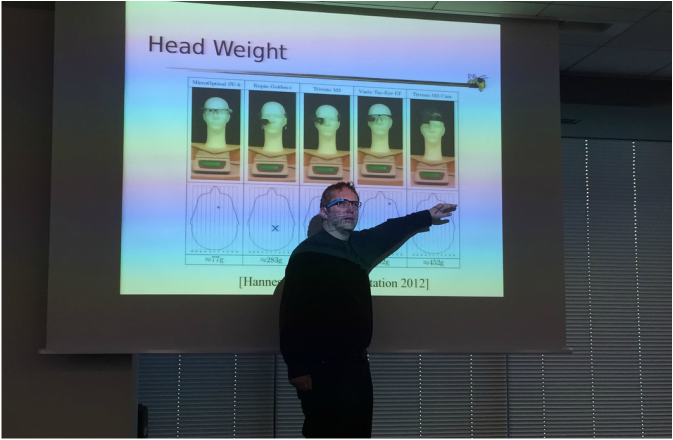The 19th International Symposium on Wearable Computers in Osaka, where I presented a paper about current developments in jewelry-like wearable devices, was a full on adventure! It was my first time in Japan, and inevitably I combined research with holidays, which guaranteed sensory overload.
After a week of being thrown between extremes of zen gardens and loudly animated building-sized adverts in Kyoto and Tokyo, I had to come to terms that Japan is not like anything I imagine it might be, and instead is far far stranger. But despite this, nothing prepared me for having Thad Starner in a role of historian as a first speaker at the Wear & Tear workshop, organised by Peter Presti, Scott Gilliland, Abdelkareem Bedri and Clint Zeagler from Georgia Tech Wearable Computing Center. Some of the early wearable computers with head-mounted displays that Thad talked about could be seen at GT's dedicated online exhibition. The whole workshop was exceptionally packed by examples of practical and unusual applications of tech from designing waterproof hardware, to challenges and opportunities of multi-disciplinary design, to quirks of Giancarlo Valentín's prototypes for interaction with dogs. And by the end of the day, I became absolutely smitten by the the open-source wearable studio, created by Andrew Quitmeyer and Hannah Perner-Wilson. Everyone should have one!
The following day's BodySenseUX workshop, presented by Assunta Matassa and Leonardo Angelini, was a true multi-sensory experience. The workshop started out by by the ice-braking cards, designed by Robb Mitchell. This was followed by the array of multi-sensory and multi-modal oriented projects and research presentations, from interactive maps for blind people by Luca Brayda, to new frameworks for The Situative Space Model in wearable computing by Thomas Pederson & Shahram Jalaliniya, to deceivingly simple communication window by Leonardo. During the last part of the workshop, Assunta gave a brief introduction of Critical Design, Design Fiction and Ambiguity as a Design Tool. And off we went coming up with the ideas on multi-modal interaction with the topic of our choice. But before we began, we had to loosen up by blowing bubbles, using our senses, and then.. eating a pop rocks candy to the sounds and video of the rain.. and I have to say that the latter created a completely novel multi-sensory illusion! The results of the rest of the workshop session were fascinating. Not least because I had chance to peak into the engineering mind of Shahram and learned a simple new trick for organising complex information by creating 'design space', unlike anything I came across during my two decades of practicing design.
The following days of the conference consisted of social and informational bullet train that went from the privacy considerations <> to tangible questioner by Sarah and Connie, horseplay by <>, to rather likeable drones by <> and <>, to animated dress by <> and textile connections by <>, and many many others to numerous to mentioned. My own talk, hosted by <> led me to discovery of work by Sarah <> and re-confirm Sarah <>'s suggestion that Nottingham university is a place to behold in their work that they do in multidisciplinary research and evolving craft practices. And speaking of practices design show, organised by <> and <> was nothing to be snared at. I think my favourite, was a little kimono <> by <>, but I also loved <> by <>.., the fiberoptic EEG controlled dress by Rain Ashford, the some digital jewelry by <> and the infamous halo. But the highlight of the earlier gadget show was an original <finger ring>, created by <> way way back in 1993, and still working! All of these are in the images above, curtesy ISWC.

 RSS Feed
RSS Feed
